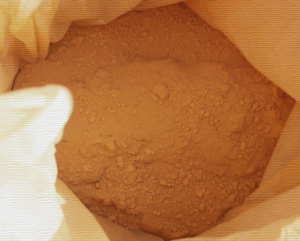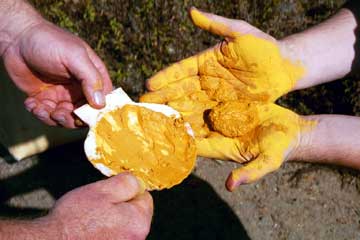YELLOW OXIDE
What is Limonite?
Before modern mineral analysis, the name “limonite” was given to many of the yellowish to yellowish brown iron oxides produced during the weathering of iron-bearing rocks or deposited as bog, lake, and shallow marine sediments.
Researchers who studied “limonite” discovered that it is amorphous and has a variable composition. It often contains significant amounts of iron oxide minerals such as goethite
Revealed that the material called
the definition of a mineral. Instead,
Mainly of hydrous iron oxides that are often found in intimate associations with iron minerals.
Physical Properties of Limonite
| Chemical Classification | amorphous, mineraloid |
| Color | yellowish brown to brown to black |
| Streak | yellowish brown |
| Luster | dull to earthy |
| Diaphaneity | opaque |
| Cleavage | does not cleave because it has an amorphous structure |
| Mohs Hardness | 1 to 5 (weathered material can be deceptively soft) |
| Specific Gravity | 2.7 to 4.3 (varies due to impurities) |
| Diagnostic Properties | variable – can be yellow-brown, brown, reddish brown |
| Chemical Composition | a hydrated iron oxide of variable composition |
| Crystal System | amorphous to cryptocrystalline |
| Uses | ocher pigments, a minor ore of iron |
Today the word “limonite” is used as a field and classroom term for these materials because they cannot be identified in hand specimens and their identity is unknown without laboratory testing. The time and expense required to do this testing is generally not needed, unless the material is going to be used in industry or it is the subject of a
Detailed study. Thus the name “limonite” is not obsolete; it is still
Limonite usually occurs as a secondary material, formed from the weathering of hematite, magnetite, pyrite, and other iron-bearing materials. Limonite is often stalactite, Reni form, botryoidally, or mammillary in habit rather than crystalline. It also occurs as pseudo morphs and coatings on the walls of fractures and cavities.
Some limonite is found in stratified deposits where hydrous iron oxides form as precipitated sediment on the floor of shallow swamps, lakes, and marine environments. These can be of inorganic or biogenic origin.
Limonite often forms as a precipitate at springs and mine openings where acidic, iron-laden waters emerge from the subsurface. Most subsurface waters contain very little oxygen, and when they discharge to the surface, they often encounter oxygenated waters. Dissolved metals in the groundwater rapidly combine with the dissolved oxygen of the surface water to form a precipitate that falls onto the bed of the stream. This precipitate is a characteristic sign of acid mine drainage.
Limonite is very resistant to weathering and often accumulates as a residual deposit. It is often the main form of iron and colorant in lateritic soils


